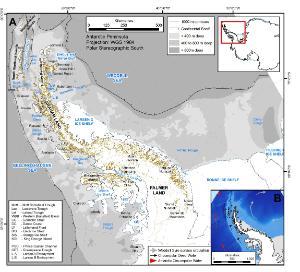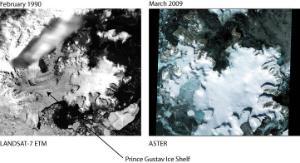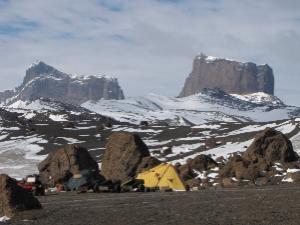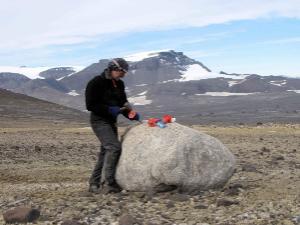Glacial history of the NE Antarctic Peninsula on centennial to millennial timescales
 CfG staff: , Neil Glasser, Mike Hambrey
CfG staff: , Neil Glasser, Mike Hambrey
Key collaborators: University of Leicester, University of Leeds, NSIDC (USA), Victoria University of Wellington (New Zealand), Toulouse University (France), Scottish Universities Environmental Research Centre.
Overview:
This project aims to reconstruct the glacial history of the NE Antarctic Peninsula region (Figure 1) over centennial to millennial timescales. We will test the hypotheses that former ice-shelf collapse events (Figure 2) left a distinctive onshore geomorphological and sedimentological signature, and that the dynamic response of feeder glaciers to ice shelf collapse can be detected and dated. The project will focus on three important issues:
- The timing and style of post-Last Glacial Maximum (LGM) retreat along the eastern margin of the Antarctic Peninsula ice sheet;
 The long-term response of tributary glaciers to previous ice-shelf collapse events;
The long-term response of tributary glaciers to previous ice-shelf collapse events;- The recent changes in Antarctic Peninsula ice shelves and tributary glaciers.
The project scientists will develop a terrestrial chronology to test the deglaciation of the eastern margin of the ice sheet, which is currently derived solely from marine data. We will also determine whether the local ice caps behaved synchronously or independently of the Antarctic Peninsula Ice Sheet (APIS). The geographical focus of this project is James Ross Island, Vega Island and the adjacent Antarctic Peninsula. These areas have a well-preserved terrestrial record of deglaciation, but one which is largely unexploited.
 This NERC-funded project began in April 2010 and will run until April 2014. It involves investigators from the Centre of Glaciology, Aberystwyth University, and from the Universities of Leeds and Leicester.
This NERC-funded project began in April 2010 and will run until April 2014. It involves investigators from the Centre of Glaciology, Aberystwyth University, and from the Universities of Leeds and Leicester.
Research highlights to date include a new understanding of Antarctic Peninsula ice sheet dynamics, and glacier sensitivity to climate change through the Last Glacial Maximum and Holocene, and an assessment of recent glacier response to climate warming and ice-shelf collapse around the Antarctic Peninsula.
The project was supported by three field seasons, two to James Ross Island (January 2011, March 2012, Figure 3) and one to Ablation Point Massif, Alexander Island (November 2012). These field seasons, supported by the British Antarctic Survey and with deployment by ship and aeroplane, were vital for collecting rocks for exposure age dating (Figure 4). Combined with glacial geological mapping, these exposure ages help us to reconstruct rates of ice sheet thinning and recession.
Our ice sheet reconstructions are related to climate through the use of numerical models. This work was primarily undertaken by Bethan Davies as a SCAR (Scientific Committee for Antarctic Research) visiting Victoria University of Wellington.
Davies, B.J., Glasser, N.F., Carrivick, J.L., Hambrey, M.J., Smellie, J.L., & Nývlt, D. 2013. Landscape evolution and ice-sheet behaviour in a semi-arid polar environment: James Ross Island, NE Antarctic Peninsula. In: Hambrey, M.H., Barker, P.F., Barrett, P.J., Bowman, V.C., Davies, B.J., Smellie, J.L. & Tranter, M., (Eds.) 2013. Antarctic Palaeoenvironments and Earth Surface Processes. Geol. Soc. of London Spec. Publ., Volume 381, 353-395. doi:10.1144/SP381.1
Carrivick, J.L. Davies, B.J., Glasser, N.F., & Nývlt, D., 2012. Late Holocene changes in character and behaviour of land-terminating glaciers on James Ross Island, Antarctica. Journal of Glaciology 58 (212), 1176-1190. http://dx.doi.org/10.3189/2012JoG11J148
Davies, B.J.,Carrivick, J.L., Glasser, N.F., Hambrey, M.J., & Smellie, J.S., 2012. Variable glacier response to atmospheric warming, northern Antarctic Peninsula, 1988–2009. The Cryosphere 6, 1031-1048. doi:10.5194/tc-6-1031-2012
Davies, B.J., Hambrey, M.H., Smellie, J.S., Carrivick, J.L., & Glasser, N.F., 2012. Antarctic Peninsula Ice Sheet evolution during the Cenozoic Era. Quaternary Science Reviews 31, 30-66. http://dx.doi.org/10.1016/j.quascirev.2011.10.012
Hambrey, M.J. and Glasser, N.F. 2012. Discriminating glacier thermal and dynamic regimes in the sedimentary record. Sedimentary Geology 251, 1-33. Online Access
Glasser, N.F., Scambos, T.A., Bohlander, J., Truffer, M., Pettit, E., & Davies, B.J., 2011. From ice-shelf tributary to tidewater glacier: continued rapid recession, acceleration and thinning of Röhss Glacier following the 1995 collapse of the Prince Gustav Ice Shelf, Antarctic Peninsula. Journal of Glaciology 57, 397-406. http://dx.doi.org/10.3189/002214311796905578
Hambrey M.J, Smellie J, Nelson A, Johnson J. 2008. Late Cenozoic glacier-volcano interaction on James Ross Island and adjacent areas, Antarctic Peninsula region. Geological Society of America Bulletin, 120: 709-731 doi:10.1130/B26242.1
Hambrey M.J, Smellie J.L. 2006. Distribution, lithofacies and environmental context of Neogene glacial sequences on James Ross and Vega Islands, Antarctic Peninsula. Cretaceous-Tertiary High-Latitude Palaeoenvironments, James Ross Basin, Antarctica, 258: 187-200. doi: 10.1144/GSL.SP.2006.258.01.14

